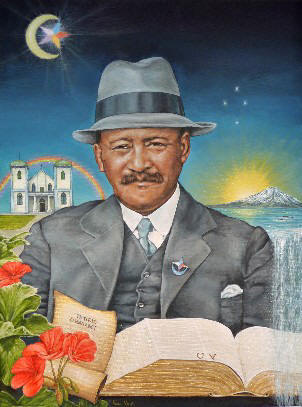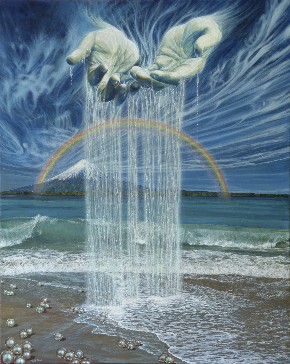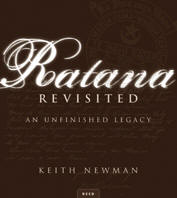|
T.W. Ratana 'iconic portrait'
and Healing Hands |
|
One
of New Zealand's most skilled portrait artists Paula Novak
brings together the key symbols and elements to celebrate the life
of Maori prophet Tahupotiki Wiremu Ratana.  T.W.
Ratana iconic portrait. From the skilled artistry of one of New
Zealand's most skilled portrait artists Paula Novak brings
together the key symbols and elements to celebrate the life of Maori
prophet Tahupotiki Wiremu Ratana. T.W.
Ratana iconic portrait. From the skilled artistry of one of New
Zealand's most skilled portrait artists Paula Novak brings
together the key symbols and elements to celebrate the life of Maori
prophet Tahupotiki Wiremu Ratana.In 1918 Ratana and his family were fishing at the mouth of the Whangaehu River when two whales came crashing to the shore. One died after thrashing about on the shore and was used to provide oil for the lanterns at Ratana Pa during the early days of Ratana's healing ministry. The other whale revived after Ratana carved his name on its side and whispered to it to go to the four corners of the world and return when his work was completed . The first whale named after Ratana's son Arepa (Alpha) was known as the 'Bible whale' representing the Ture Wairua or spiritual works and the second was identified with his son Omeka (Omega) was the 'Treaty whale' representing the Ture Tangata or the physical works. Ratana took the encounter with the whales as a sign that he had been called to help his people. Shortly after he had a vision confirming this with the voice of the Wairua Tapu (Holy Spirit) telling him to heal the sick and call the Maori people away from their superstitions and belief in the 'old gods' to unite under Ihoa o nga Manu (Jehovah of the Multitudes). This iconic portrait features the Ratana whetu marama (star and moon) tohu or symbol representing Father, Son and Holy Spirit, the angels and the enlightenment that Ratana was to bring to the Maori people as Mangai or mouthpiece representing the Maori political or Kotahitangi (unity) movement and the long lineage of Maori prophets who had pointed to his arising between the two world wars. Over his right shoulder is the Ratana Temple, over his left is Mt Taranaki and the flow from Te Rere O Kapuni the waterfall of the prophets. To his front right is the symbolic geranium he planted from his garden at the site of the present day Beehive, saying one day he would pluck a flower from it and its pollen would be blown to the four winds. Ratana, as he had prophesied, ended up with his representatives taking all four Maori seats in Parliament. Front left is the Paipera Tapu (Bible). Ratana was a true believer in the Bible. He healed many thousands in the name of Ihu Karaiti (Tama, the Son) and urged his people to read the Bible. He said he held the Bible in his right hand and the Treaty of Waitangi in his left, if everything was put right spiritually the physical works would take care of themselves. This painting was created by Paula Novak for inclusion in the new book Ratana - the Prophet (Penguin 2009) and the first copies of this 300 print limited edition were given to key members in the Ratana movement.
|
Healing Hands,
with Mt Taranaki as the backdrop to a heavenly waterfall and
rainbow is symbolic of personal healing and renewal. The canvas
speaks strongly about restoration and healing of the land around
Taranaki after the turbulent conflicts over Maori land between the 1860s
- 1880s. The pearls, could also represent economic and spiritual wealth, and the powerful legacy of handling conflict through non-violent and peaceful resistance as demonstrated by Parihaka chiefs Te Whiti O Rongomai and Tohu Kakahi.
The
original ‘Healing Hands’ acrylic on canvas painting by Paula Novak
is 80 x 100cm in dimension
and
owned by a New Plymouth business woman.
|

